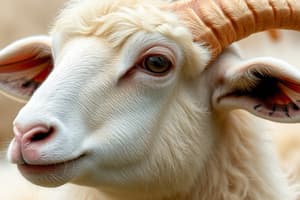Podcast
Questions and Answers
What is flystrike primarily caused by in sheep?
What is flystrike primarily caused by in sheep?
- Poor nutrition
- Parasitic maggots from flies (correct)
- Fungal growth
- Bacterial infection
Which of the following signs might indicate that a sheep is suffering from flystrike?
Which of the following signs might indicate that a sheep is suffering from flystrike?
- Increased wool growth
- Loss of appetite and agitation (correct)
- Weight gain
- Enhanced social interaction with other sheep
What is a significant risk factor for flystrike in sheep?
What is a significant risk factor for flystrike in sheep?
- Thick wool becoming soiled (correct)
- Regular shearing
- Excessive heat exposure
- High protein diet
Which fly species is responsible for approximately 90% of flystrike infestations in Australia?
Which fly species is responsible for approximately 90% of flystrike infestations in Australia?
How do maggots contribute to the spread of flystrike in a flock of sheep?
How do maggots contribute to the spread of flystrike in a flock of sheep?
What characteristic appearance is associated with flystruck sheep?
What characteristic appearance is associated with flystruck sheep?
What is one potential consequence of flystrike in sheep?
What is one potential consequence of flystrike in sheep?
Where within the flock can flystrike commonly occur, aside from the already infected areas?
Where within the flock can flystrike commonly occur, aside from the already infected areas?
Flashcards are hidden until you start studying
Study Notes
Flystrike in Sheep
- Myiasis condition caused by parasitic flies infecting domestic sheep.
- Thick wool contaminated with urine and fecal matter creates breeding grounds for maggots, even without wounds.
- Flies lay eggs on soiled wool or open wounds; maggots hatch and burrow into the sheep's flesh.
- After larvae develop, flies lay eggs on new or infected sheep, perpetuating the cycle of infestation.
- Symptoms include agitation, loss of appetite, unpleasant odor, and matted wool, attracting more flies.
- Ammonia poisoning can result from flystrike, making it potentially lethal for sheep.
- Infestation causes economic losses due to stock degradation and increased management expenses.
Flystrike Causes and Effects
- In Australia, Lucilia cuprina accounts for approximately 90% of infestations.
- Chrysomya rufifacies is the main secondary pest, targeting wounds from L. cuprina.
- Flystruck sheep show green or wet-looking fleece patches, particularly around the haunches, tail, or wounds.
- Penile area in male sheep is also a common flystrike site.
- Infected sheep display agitation behaviors such as foot stamping or nibbling at their body.
- Severe cases can lead to shedding of wet-looking wool and produce a strong characteristic odor.
Environmental Factors
- Optimal conditions for flystrike include temperatures between 15–38°C (59–100°F), recent rainfall, and wind speeds under 9 km/h (5.6 mph).
- UK peak breeding season for green bottle flies generally occurs in late June or July, though infestations can happen any time warm, damp conditions are present.
Prevention and Management
- Various preventative measures exist to minimize flystrike risk in sheep flocks.
- No single measure can entirely prevent flystrike; regular treatment and monitoring are essential for effective management.
Studying That Suits You
Use AI to generate personalized quizzes and flashcards to suit your learning preferences.




